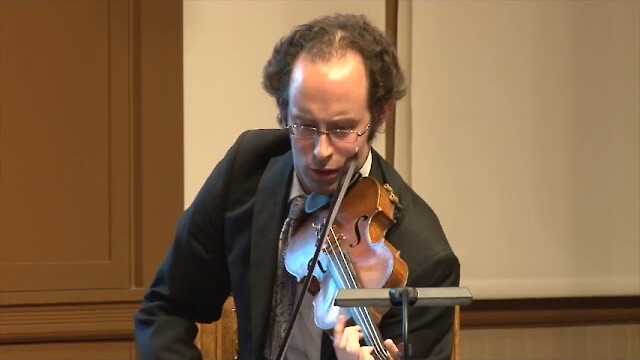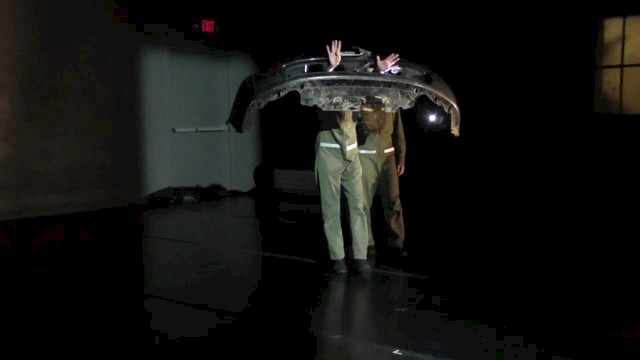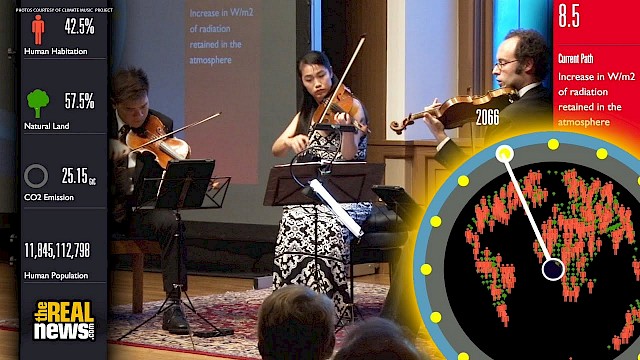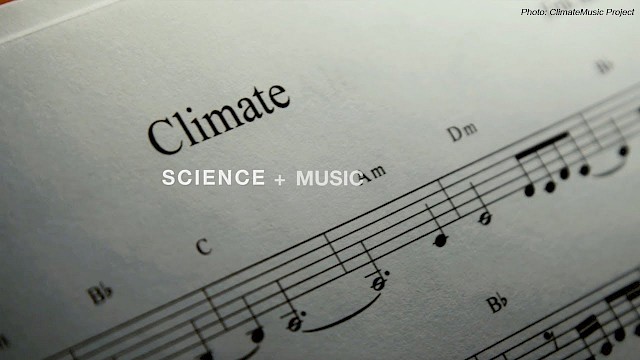String Quartet No. 4 ("Icarus in Flight")
- Year
- 2018
- Duration
- 27'
- Category
- Chamber
- Premiere
- June, 1st 2018
Noe Valley Chamber Music, San Francisco
Telegraph String Quartet - Publisher
- Wildcat Canyon Music Press
Program Notes
Icarus in Flight
In modeling the earth¹s changing climate, my new quartet, Icarus in Flight, uses historical data on
population growth, carbon emissions and land-use transformation, during the period 1880 projected out to 2080, to control certain aspects of the music.- Population growth controls the average density of musical events over time, increasing, in the worst case, by a factor of 9. In this context, density means the number of musical events in a given time period (if more than one instrument initiates an event at the same time it is still considered one event).
- Carbon emissions control the frequency range of the music, from lowest to highest pitch, increasing gradually from a perfect fifth in the middle register to a span of 6.25 octaves, before collapsing to almost nothing.
- With respect to land-use, an increase from 13% to 43% of the earth¹s land surface devoted to human use (i.e. habitation, agriculture and grazing) is represented by the increasing proportion of music that is played with specialized timbres (tone colors), including mainly pizzicato, tremolo bowing, and bowing close to the bridge (producing a fragile timbre characterized by a greater proportion of high frequency partials).
The era of international cooperation on climate change begins circa 1979. If one listens closely one can hear fleeting moments of repose on the interval of a major 3rd marking the dates of international meetings.
Icarus in Flight is comprised of three large sections played without pause: the first representing the years 1880 to 1945, when the data are growing slowly; the second from 1945 to 2015 when growth accelerates exponentially; and the third from 2015 to 2080. In the last section, our future, the controlling data alternate between the best and worst case future scenarios (i.e., representative climate pathways 2.6 and 8.5) based on the models developed by the Inter-governmental Panel on Climate Change (IPCC), a scientific body under the auspices of the United Nations. Each year occupies eight seconds of musical time, the entire piece lasting about 27 minutes
Reviews
Lorraine Byrne Bodley discusses Icarus in Flight
Live! From San Francisco and Vienna:
An Extraordinary Concert for Climate Action
WHEN
Friday, November 12, 2021, 19:00 - 21:30
WHERE
Dargan Lecture Theatre, Trinity College of Dublin and onlineReflection and panel discussion with climate and arts experts
Chair: Jennifer McElwain, MRIA, Director of the Programme for Experimental Atmospheres and Climate Lab, and Leader of Plant Palaeobiology and Palaeoecology group at Trinity College, Dublin; and the two panelist were:
Panelists:
Peter Thorne, Professor of Climatology at Maynooth College, Dublin; director of ICARUS (Irish Climate Analysis and Research UnitS group); lead author of two of the Intergovernmental Panel on Climate Change reports, AR5 which is the 5th report, and AR6 which is soon to be published.
Lorraine Byrne Bodley, Member of the Royal Irish Academy, Professor of Musicology, Maynooth College Dublin; President of Musicology in Ireland; member of the Royal Irish Academy; she’s considered the foremost scholar globally on the subjects of Goethe and music, and Schubert.
Organized by the Royal Irish Academy Climate Change and Environmental Sciences Committee in partnership with Arup. Hosted by Trinity Business School
Jennifer:
…still be able to deconstruct some of the amazing music we’ve heard tonight. So, we’re going to have a… join us for a short panel – come up, my panel. So hopefully we’ll have no more technical issues.
Peter:
[Laughs] At least we have control of them.
Jennifer:
Yeah… so we’ll see, is everybody ready?… okay… so… Well thank you so much again for joining us tonight. I’m delighted to introduce the panel. So I’d like to introduce Professor Lorraine Byrne Bodley, who is a professor of musicology in Maynooth, and she is the President of Musicology in Ireland; in 2015 she was elected to the Royal Irish Academy; she’s considered the foremost scholar globally in Goethe and music, and also Schubert. This is Peter Thorne, he’s Professor of Climatology at Maynooth, he’s the director of ICARUS (Irish Climate Analysis and Research UnitS group), and after hearing Icarus in Flight tonight, flying too high and burning his wings, I think it’s a very clever acronym. So Peter is the lead author of two of the IPCC – so that’s the Intergovernmental Panel on Climate Change – reports, AR5 which is the 5th report, and AR6 which is soon to be out. So I’m really interested to hear – I suppose we’ve really heard this incredible eclectic mix of music tonight after some fairly shaky starts with the technology where I felt like I was going to sink into the ground. I think… I, I really, really felt moved, and what I want to really focus on is the composer Richard Festinger’s Icarus in Flight. So I’d like to start with Lorraine… I’m really interested in your personal and also your professional response to that piece, Icarus in Flight.
Lorraine:
Thank you Jenny. I’m full of admiration for what Festinger has achieved, both in tracking the data, and also in creating a piece of music in its own right. I want to pay tribute first to the wonderful musicians, the Telegraph Quartet, because performing new music is a challenge: clarity is needed, and it’s not always guaranteed in a premiere of the performance, where if you have an orchestral work, for example, and rehearsal time is limited, often that kind of precision that you need in contemporary music isn’t there, that composers and audiences need, because familiarity really is the touchstone in understanding, and I thought they were just inside the performance in a wonderful way. I find the project really fascinating, and the whole idea of translating data into sound immediately makes you sit up as an audience even before you’ve heard a note of the piece, because of the whole humanitarian too, where the composer is an activist in climate amelioration, so we’re immediately interested in it; and there are huge artistic challenges involved in that kind of project. First of all, you know, with very definite data there are very strict and definite parameters that the composer has to observe; but there’s also freedom in constraint, and one of the things that I really loved about the project was the lengths that they go to, to communicate, both through music, and through the program, for example that the composer has given us; and you saw the graphic that was made for this performance too; and I find the tensions really fascinating in a project like this, because you have music and science, on the one hand, coming together, and the truth of music is very different from philosophical or scientific truth, in that it can't be verified by conventional means. When we listen to a piece of music like Festinger’s quartet, we know it works, we can hear it works, and the truth is really inherent in the musical language. But there’s also the tension of music and politics, and this piece belongs to a whole trajectory of works that embrace both, and a growing collection or body of works that address climate change. So there is that question of whether historical and political realities can really be subsumed into a work of art, and I think that Festinger really achieves that in a tremendous way, and I think you can hear the conviction in the music.
Jennifer:
Yeah, and, I mean, coming from the scientific perspective we felt – I don't know music, but I felt very uncomfortable when the music was projecting into the future for a high carbon-emission future, and then you felt more comfortable, obviously, you could feel it on a sustainable path. So could you deconstruct a little bit for the audience, so we understand how it made us feel that way?
Lorraine:
Well I think some of the details of the program were given at the beginning. Essentially it’s a 21st century piece of program music through which he’s guided us very clearly. One way of thinking about it is in terms of temporality, which was already mentioned. It’s a one-movement string quartet, and it’s divided very clearly into three sections, but without the traditional breaks that you would get in a string quartet between the four [sic.] movements. So looking at the periods of change that they mentioned, form 1880, the industrial revolution, up to 1945, where climate changes are growing very slowly, the music you heard is reasonably calm, but there is that sense of foreboding at the beginning: there is dissonance that is used, and it’s also the minor mode is used; and then in the middle section, from 1945 to 2015, the music becomes much more dense, the musical materials are different, it’s rhythmically much more engaged, more agitated, again the harmonies are much more dissonant, and the tempo accelerates; and then in the third section, where you have the two possible scenarios, so the worst case scenario, the music becomes much more cacophonic, but in the best case scenario, some of the musical materials from the beginning actually come back, and they’re used, really, in a different way, they’re transformed.
Jennifer:
Yeah. And Peter, as a scientist, I mean, your research area has been making observations of temperature on land and ocean, and as a lead author on IPCC, you have documented and pulled together that work showing our climate future, the 8.5 versus sustainable future 2.6; but how did it make you feel, the Icarus in Flight piece?
Peter:
So it was a very, very strong piece in terms of showing in particular in the final piece the difference between the futures that we might portend for ourselves, depending on our collective choices as humanity. And I think, more broadly, across the program as a whole, it highlighted to me that we need to speak in many different voices to many different audiences to reach them, and I was impressed by the breadth of the program.
Jennifer:
Yeah… And I wanted to come back to Lorraine, and as we prepared for this panel what I found really interesting is you said that music has always played an important role in political activism, and benefit concerts have an incredible history so could you tell us a little more about that?
Lorraine:
Yeah, I mentioned benefit concerts because, well, tonight’s concert, if we look at it, it’s very much part of the reality that has emerged from the pandemic. It’s fantastic to link with California and also with Vienna and here in Dublin. But it’s also part of a larger tradition of benefit concerts which are directed at very specific and immediate humanitarian causes, and often they have very subjective and concrete objectives, so an example of subjective objectives would be raising awareness of an issue, so for example, misery in Africa, or uplifting a nation after a disaster, like the America Tribute to Heros concert. And then examples of concrete objectives would be raising funds, as in live aid, and also influencing legislation. One of the features of benefit concerts is having fantastic musicians involved, because that invites audience in to listen, and then where you have the audience captive, and listening to the music, it’s a chance to actually discuss the issues which give rise to the concert in the first place. And often benefit concerts have singing involved, as we heard tonight, because when people sing together they come together, and they’re much more likely to support a cause and act in favor of that cause. But it’s not just a 20th century phenomenon, if we go back to the 19th century or the 18th century, to give you an example from then, foundling hospitals were at the core of funding in the 18th and 19th centuries, so Handel conducted performances of Messiah every year to raise funds for the foundling hospital in London. He also wrote a foundling anthem for people to sing together, and because Vienna was part of our concert as well, if we look there, Schubert, for example, often wrote music about orphans, because this was topical, too, in Vienna. His eldest brother, his parents’ first child, was actually handed in to a foundling hospital in Vienna and died within two weeks, and this was very typical of the time: only 7% of babies lived, survived, most died within two weeks of malnutrition, and because of lack of sanitation in the hospitals, and because of lack of human warmth. So it was something that people were very aware of, and music that was written drew attention to this, and Joseph II introduced quite a lot of reform towards legitimizing children, founding orphanages with were proper educational establishments to offer a pathway out of poverty. And you have a whole tradition of this, widows and orphans concerts, from the 18th and 19th centuries right up until after the First World War there was an orphans and widows concert in the Konzerthaus in Vienna for the widows and orphans of Hungarian soldiers. So it’s not just benefit concerts as well, sometimes genres in music can actually be used to mobilize change in society, so to give you just one example, melodrama is a 19th century form, and it grew out of society’s preoccupation with texted music, so song and opera for example. And melodrama is where you have the spoken voice, an actor or an actress, singing (sic) over an orchestral accompaniment usually, or it can be written for piano accompaniment. So it was usually historically considered kind of a curiosity, you know, an experiment that was popular at either end of the 19th century. But actually if you look at the texts of it, it’s often based on mythology, and a woman is at the center. And it was a cultural voice piece for propelling change in society, so women’s’ rights, and women being subject opt the authority of the father, and then a husband, and not having any political rights, or, you know, looking at divorce, or a woman’s right to hold her children, keep her children after divorce, these were issues that were raised in melodrama, and it raises the question of whether art is actually reflecting society, or whether art is actually raising questions for society to consider; so there’s a whole history of this.
Jennifer:
Yeah. And I think as scientists, we often, I think we probably do a poor job of trying, you know, to communicate with so many different audiences, where music has this power to do that... In the context o climate change, this is what we really now need is collective action, scaling up to collectively feel part of something, to utilize the solutions that are out there, so I suppose my huge question to you is: does music have the power to change the world?
Lorraine:
Absolutely, but not in any naïve sense. You know, the concerts that we spoke about, they’re of proven effectiveness in raising awareness, in mobilizing change. I was lucky enough when I was starting [ ] to have first-hand experience in a project: it was an opera I wanted to see staged, and in order to get funding I got North-South funding, so half the cast were from the north, half from the south, and it was a one-act opera which was originally complete, and we rehearsed it, and conflict was at the core, so it allowed the cast to talk about issues of conflict and solve the conflict, and I saw the impact it had on people, I saw the impact it had on the cast, it doesn’t immobilize change, but it’s a stepping stone, and it was in the right direction, and to look at the piece that was written […] a couple of years ago and performed this evening, Icarus in Flight, I hope that that goes on tour when possible, I hope that performance will be taken up by other quartets, and to focus in on the third section of the work, and the two pathways, the composer and the quartet felt very, very strongly about leaving the audience with a sense of optimism, because hope propels change, and to embrace the Viennese part of the concert, Schubert wrote a lot in letters to friends, and diaries, about music transporting him to a better world. And that’s more than escape. It’s about the uplifting, and quality that we have being uplifted by music when personal and political realities feel overwhelming. The poet Wallace Stevens spoke a lot about the confrontation between reality and the imagination that forms the basis of art, and very famously he defines poetry as a violence within pressing back, or protecting us, from a violence without, the pressure of the imagination pressing against reality, and often the pressure of reality is the determining factor in the artistic character of a piece of music, and that’s why sound helps us to live our lives: music helps us to order our thoughts, it helps us to make sense of our lives, and, you know, the concert that we heard this evening connects us with the history of musical language, we heard many musical languages, from hip-hop to tango with Astor Piazzola, we heard contemporary music in that context, we heard examples of song as social document, and so the music connects us with all kinds of human encounters with the realities that surround those composers, and connects us with the history of human success in that struggle for spiritual survival. So I really do feel, yes, music does have the ability to change our worlds, I do think it’s possible to shine a light, to be a compass, and you, Jenny, have done that by organizing this evening, Festinger has done that by composing this piece of music, the Telegraph Quartet, all the musicians that played tonight, are part of that: they’re stepping stones, but they’re stepping stones in the right direction.
– Royal Irish Academy
Ordering Information
For pricing info and to order this work, please fill out the form below:




